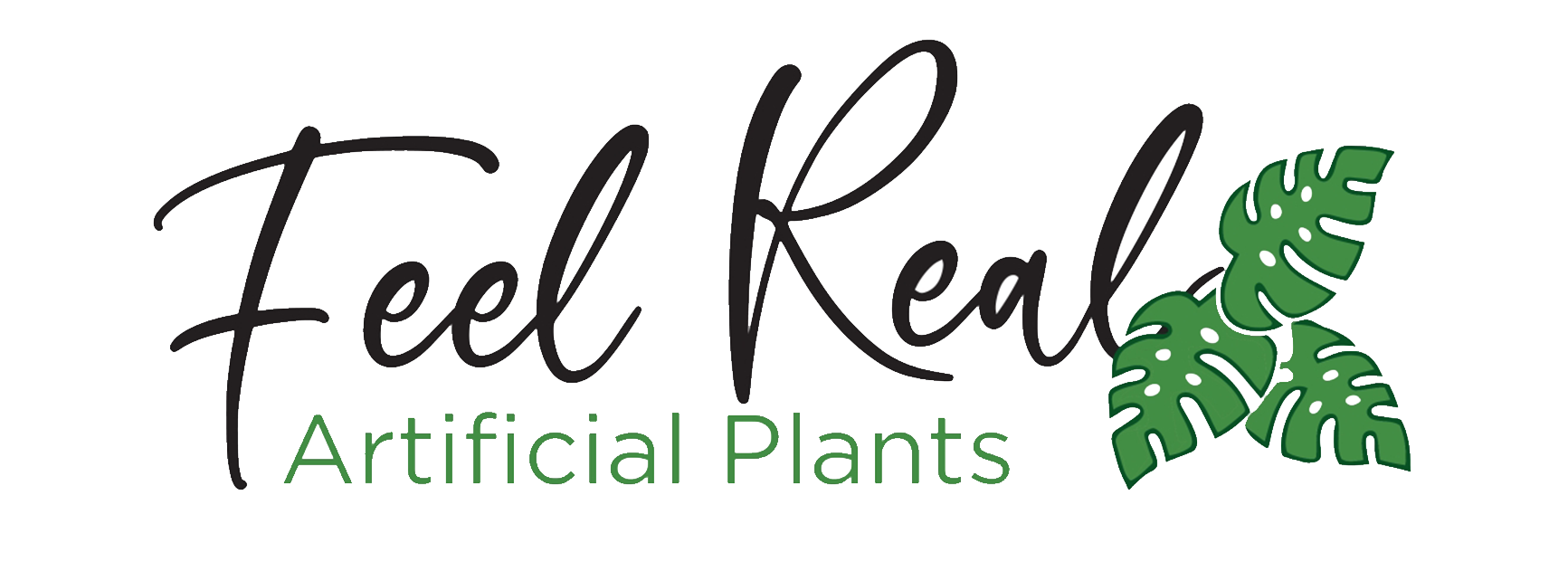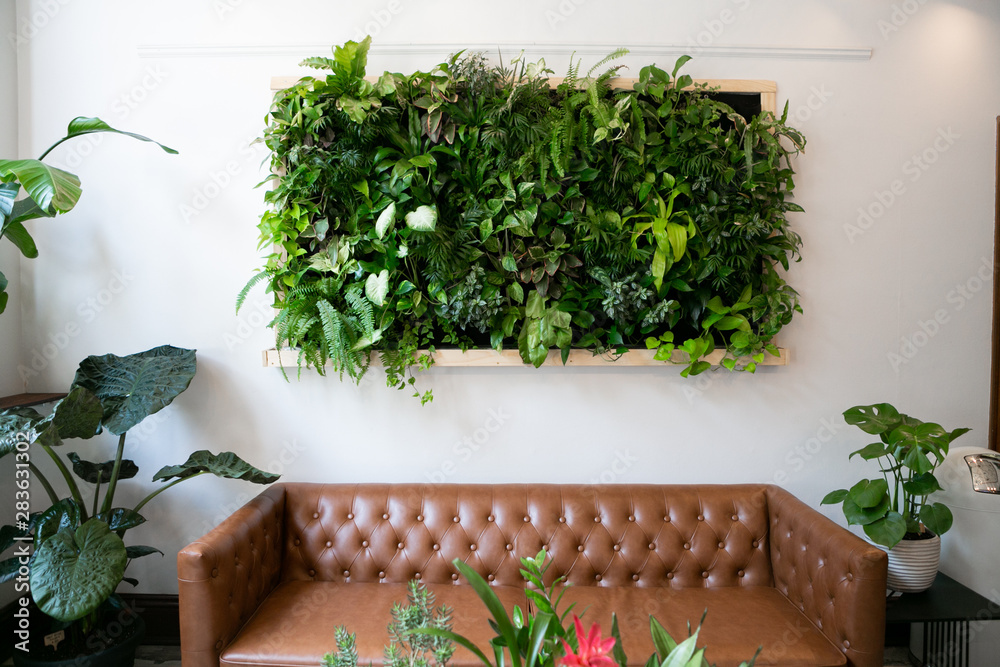Green walls, a stunning and increasingly popular feature in both indoor and outdoor spaces, have a transformative effect on the ambiance of any area. While live plant walls have their charm, artificial green walls offer a practical and long-lasting alternative, especially for spaces where maintaining live plants is challenging.

The concept of green walls has taken a significant leap forward with the introduction of artificial plants, offering a sustainable and versatile alternative to traditional living walls. In the artificial plant industry, there is a golden opportunity to capitalize on this trend. This article delves into the various aspects of creating and marketing green walls using artificial plants.
– The Rising Popularity of Artificial Green Walls
The increasing popularity of artificial green walls is a testament to the evolving landscape of interior and exterior design preferences. These walls, which mimic the appearance of live plants, have become a preferred choice for many due to the high maintenance demands associated with real greenery. For businesses and homeowners alike, the allure of these faux green walls lies in their ability to provide the visual benefits of natural plants without the ongoing care and attention required.
This trend is particularly advantageous for wholesalers in the plant and decor industry. The rise in demand for artificial green walls opens up new avenues for market expansion and diversification. Wholesalers who adeptly understand and cater to the specific needs of their customers – prioritizing aesthetics, durability, and ease of maintenance – can effectively broaden their market presence. By offering a range of high-quality, lifelike artificial green walls, you can appeal to a wider customer base that values both the beauty of greenery and the convenience of low-maintenance solutions.
Furthermore, this shift in consumer preference provides an opportunity for you to innovate and differentiate your products. By incorporating the latest materials and technologies, you can enhance the realism and quality of artificial green walls, making them even more attractive to customers seeking sustainable and hassle-free decorative options. This approach not only meets the current market demand but also positions wholesalers as forward-thinking leaders in the industry.
– Understanding the Benefits and Advantages
One of the primary advantages of these faux walls is their minimal maintenance requirements. Unlike living green walls, artificial ones do not require watering, pruning, or exposure to sunlight. This feature is especially appealing in urban settings, where space constraints and fast-paced lifestyles make the care of live plants challenging.
Another significant benefit is their immunity to seasonal changes. Real plants undergo transformations with the seasons, which can affect their appearance and require additional care. In contrast, artificial green walls maintain their lush, vibrant look throughout the year, offering consistent aesthetic appeal. This feature is particularly attractive for businesses and homeowners who want to ensure their spaces remain visually appealing regardless of the season.
For wholesalers, effectively communicating these advantages is key to attracting potential clients. Marketing strategies should focus on the convenience and consistent beauty of artificial green walls. Emphasizing their suitability for various settings, including those where live plant maintenance is impractical, can broaden their appeal. Additionally, highlighting the cost-effectiveness over the long term – considering the saved expenses on plant care and replacement – can be a persuasive selling point.

Incorporating testimonials or case studies in marketing materials can also be effective. Showcasing successful installations in diverse environments, such as office buildings, retail spaces, or residential areas, can demonstrate the versatility and impact of these products. By presenting a strong case for the practical and aesthetic benefits of artificial green walls, you can capture the attention and interest of a wide range of clients, from corporate decision-makers to individual homeowners.
– The Popular Types of Artificial Plants Can Be Used for Green Walls
When it comes to designing green walls using artificial plants, the variety and types of faux foliage you choose can significantly impact the overall aesthetic and appeal of the installation. Here’s a look at some of the most popular types of artificial plants that are ideal for creating lush, vibrant green walls:
Artificial Ivy: Ivy is a classic choice for green walls due to its dense foliage and trailing vines. Artificial ivy can create a lush, overflowing effect, ideal for covering large areas. It’s available in various shades of green and variegated patterns, allowing for a rich, textured look.
Faux Ferns: Ferns add a sense of depth and variety to green walls with their unique leaf shapes and sizes. They are perfect for adding a touch of wilderness and work well in combination with other plant types. Artificial ferns maintain their vibrant green appearance without the need for sunlight or water.
Silk Flowers: Incorporating silk flowers can add a pop of color and visual interest to a green wall. From bright tropical flowers to subtle pastel blooms, they can create a focal point or add a seasonal touch to the installation.
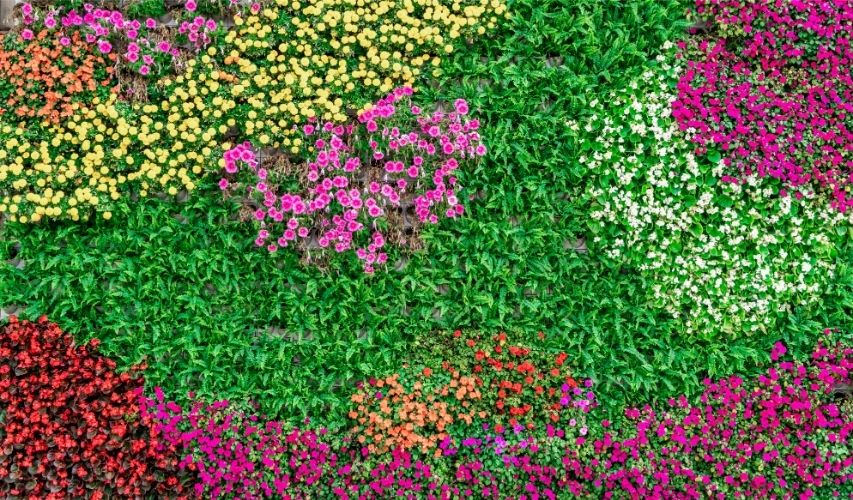
Synthetic Boxwood: Boxwood is renowned for its dense, bushy appearance, making it a great option for creating a more structured and formal look. Artificial boxwood panels are easy to install and can be trimmed to fit any size or shape, offering versatility in design.
Plastic Grasses: Tall, wispy grasses can add an element of softness and movement to a green wall. They can be used to create a natural, meadow-like effect or to add height and texture among shorter plants.
Artificial Succulents: For a modern, minimalist green wall, artificial succulents are a great choice. Their varied shapes, sizes, and colors can create an intriguing display that requires virtually no maintenance.
Moss Panels: Though not a plant in the traditional sense, moss panels are becoming increasingly popular in green wall designs. They can provide a lush, velvety backdrop or be used to create patterns and designs within the wall.
Hanging Vines: Artificial hanging vines can be used to create a cascading effect on green walls, adding dimension and a sense of abundance. They work well in both indoor and outdoor settings and can be mixed with other plant types for a more diverse look.
Each of these types of artificial plants offers its unique charm and aesthetic, allowing for endless creativity in designing green walls. When selecting plants for a green wall, it’s essential to consider factors like the overall design theme, the intended mood of the space, and the level of realism desired. By mixing and matching different types of artificial plants, you can create a green wall that is both visually stunning and perfectly tailored to the client’s needs.
– Sizes of Artificial Green Walls
Artificial green walls come in a variety of sizes, catering to different spatial requirements and design preferences. The flexibility in size is one of the key advantages of artificial green walls, allowing them to be installed in a wide range of settings, from small residential spaces to large commercial areas. Here are some common size categories:
Custom Sizes: One of the key advantages of artificial green walls is their customizability. They can be created in almost any size, from small panels for residential use to expansive walls covering entire facades of commercial buildings.
Standard Panels: Many suppliers offer standard panel sizes, which can be easily installed and connected to cover the desired area. Common sizes might range from 50x50cm to 100x100cm panels, which can be combined to fit the specific dimensions of a wall.
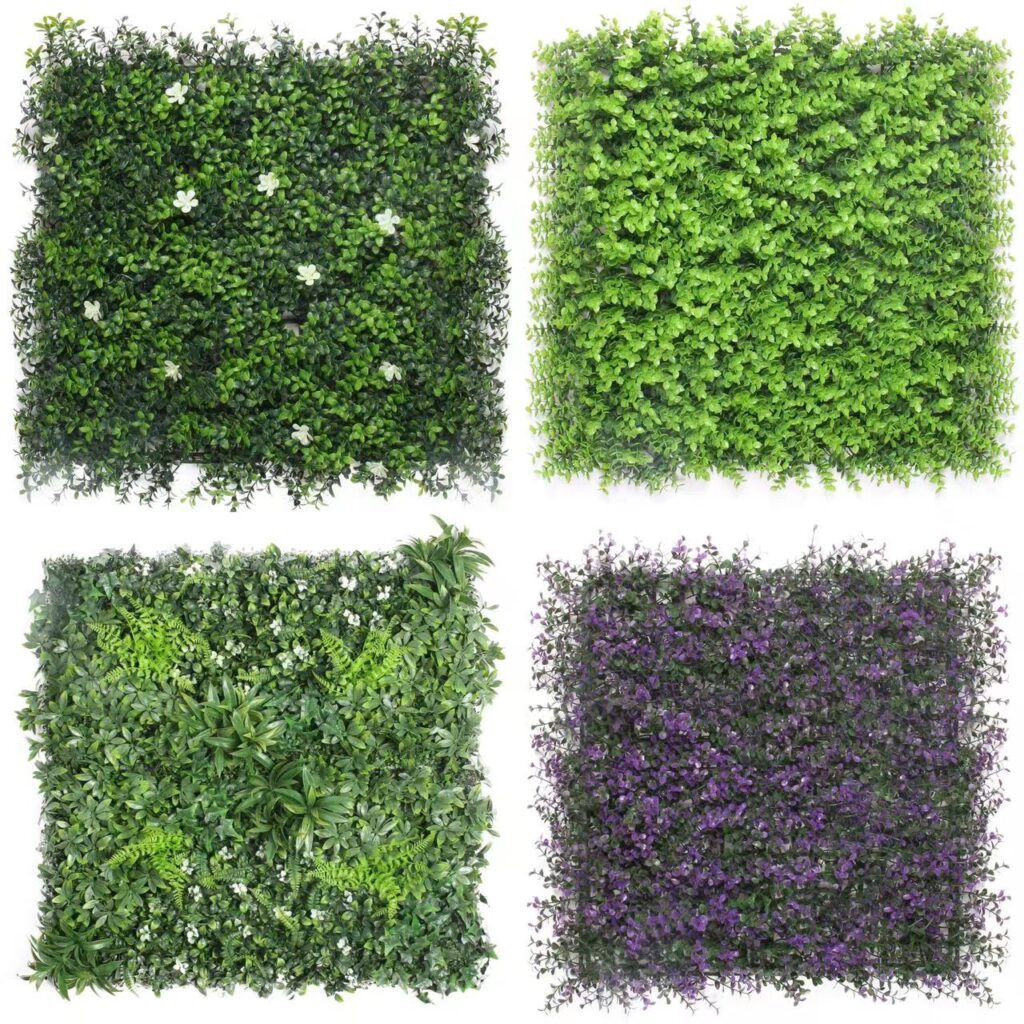
Modular Systems: Some artificial green walls come in modular systems, allowing for easy installation and rearrangement. This can be particularly useful for temporary installations or spaces that require flexibility.
– Design and Aesthetic Considerations
Design and aesthetic considerations play a pivotal role in the appeal and success of artificial green walls, making them a versatile choice for various settings. One of the key advantages of these walls is their design flexibility, which allows for a broad range of styles to suit different tastes and environments. You can leverage this by offering a diverse selection that includes everything from lush tropical looks to modern, minimalist designs. This variety ensures that clients can find a suitable match for their specific aesthetic preferences and space requirements.
The quality and realism of the artificial plants used in these walls are critical factors. High-quality, lifelike plants not only enhance the visual appeal of the walls but also contribute to their believability as real greenery. This realism is particularly important in settings where the natural look is desired, but the conditions are unsuitable for real plants.
Understanding and addressing these design and aesthetic considerations is key to meeting the needs and expectations of a diverse clientele. By offering a wide range of styles, focusing on high-quality, lifelike plants, and providing customizable options, they can cater to a broad spectrum of clients, from residential customers to corporate clients. This approach not only enhances the marketability of their products but also positions them as versatile and responsive suppliers in the evolving market of artificial green walls.
– Applications of Artificial Green Wall
Artificial green walls have a wide range of applications, offering versatility and aesthetic appeal in various settings. Their maintenance-free nature and adaptability make them ideal for numerous environments. Here are some key applications of artificial green walls:
Corporate Offices and Commercial Spaces: In corporate settings, artificial green walls can be used to create a welcoming atmosphere, enhance brand image, and provide a sense of tranquility. They can be installed in lobbies, conference rooms, or common areas to boost employee morale and impress clients.
Retail and Hospitality Industries: Shops, malls, hotels, and restaurants use artificial green walls to create an inviting and visually appealing environment. They can be utilized as feature walls, backdrop for signage, or to delineate spaces within a larger area.
Healthcare Facilities: Hospitals and clinics often incorporate artificial green walls to create a calming and restorative environment for patients and staff. These walls can help reduce stress and promote a sense of well-being, without the concerns of allergens often associated with real plants.
Residential Spaces: Homeowners use artificial green walls to bring a touch of nature indoors, especially in urban settings where outdoor space is limited. They can be used in living rooms, balconies, or as privacy screens in gardens and patios.
Event Design and Exhibitions: Artificial green walls are popular in the event industry, used as backdrops for weddings, conferences, and exhibitions. They offer a quick and effective way to transform a space and create a focal point.
Urban and Public Spaces: City planners and architects sometimes integrate artificial green walls in public spaces like subway stations, airports, and city squares to enhance urban aesthetics and create a more inviting atmosphere.

Educational Institutions: Schools and universities can use artificial green walls to create vibrant, inspiring environments for learning. These installations can also be used to educate students about sustainability and green design.
Recreational Areas and Theme Parks: In recreational settings, artificial green walls can be used to create thematic environments, provide privacy, and enhance the overall aesthetic of the space.
Outdoor Spaces in Harsh Climates: In areas with extreme weather conditions, where maintaining real plants is challenging, artificial green walls offer a durable and evergreen solution.
Film and Television Sets: For film and TV production, artificial green walls provide a controlled and consistent backdrop that can be used in various types of scenes without the unpredictability of live plants.
The applications of artificial green walls are limited only by imagination. They provide a practical and attractive solution for bringing greenery into spaces where traditional gardening is impractical or impossible. As technology and materials improve, the realism and possibilities of these installations continue to expand, making them a popular choice in a wide range of industries.
– Installation and Structural Integrity
The installation process and structural integrity are key factors in the successful implementation of artificial green walls. While these walls are generally easier to install than their live counterparts, they still require thoughtful planning and execution to ensure both durability and aesthetic appeal.
For wholesalers, providing comprehensive guidance on installation is essential. This includes advising on the selection of appropriate support structures and materials that are not only strong and durable but also complement the visual appeal of the green walls. The support structures must be capable of holding the weight of the artificial plants and panels without compromising the integrity of the wall or the building structure it’s attached to.
Offering installation services, either directly or through partnerships with professional installers, can significantly enhance the value proposition for wholesalers. This service ensures that clients have access to skilled professionals who can efficiently and correctly install the green walls, guaranteeing both safety and aesthetic quality. For clients who prefer a do-it-yourself approach, wholesalers can provide detailed installation manuals or even short video tutorials, which can be extremely helpful.
Another important aspect is the ease of installation and modification. Modular designs, for example, can enable clients to easily add or remove sections of the wall, allowing for flexibility in design and size. This adaptability is particularly appealing in commercial or retail environments where the layout or design theme may change periodically.
Simple Installation Process:
Measuring and Planning: Accurately measure the space and plan the layout of the plants. Consider using a grid system for even placement.
Mounting the Structure: Securely mount the wall structure, ensuring it can support the weight and is accessible for maintenance.
Arranging the Plants: Attach the artificial plants to the structure, keeping in mind the design and density for a natural look
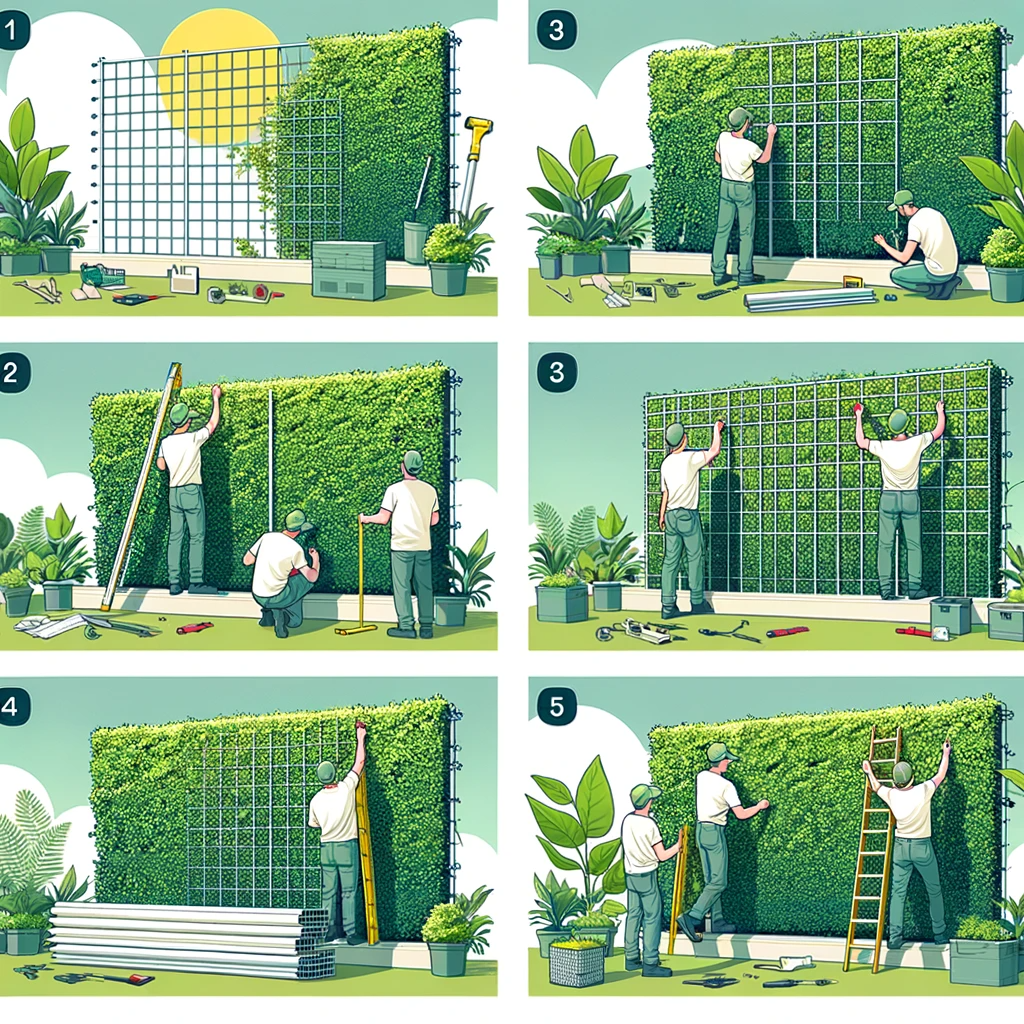
– Maintenance and Longevity
The maintenance and longevity of artificial green walls are significant factors contributing to their popularity. One of their primary advantages is the ease of maintenance compared to live plant walls. For wholesalers, effectively communicating and facilitating this aspect can greatly enhance customer satisfaction and the perceived value of their products.
Providing clear and concise guidelines on the care and cleaning of artificial green walls is essential. This information should include tips on how to dust and clean the artificial plants to keep them looking fresh and vibrant. Simple instructions on regular dusting, safe cleaning methods, and recommended cleaning products can be very helpful. This guidance not only assists in maintaining the aesthetic appeal of the walls but also extends their lifespan.
Additionally, you can consider offering specialized maintenance services. These can include periodic checks and refurbishments of the green walls. Such services could involve replacing faded or damaged plants, ensuring that the support structures are intact, and updating the design if desired by the client. By offering these services, you not only ensure the ongoing quality and appeal of their products but also establish long-term relationships with their clients.
Periodic maintenance services are particularly beneficial for corporate or commercial clients who may not have the time or resources to care for the walls themselves. These services can be structured as part of an ongoing maintenance contract, providing a steady revenue stream for wholesalers and peace of mind for clients.
– Customization Options for Unique Spaces
Customization options play a crucial role in the appeal of artificial green walls, as they offer the flexibility to tailor these installations to unique spaces and specific client needs. Wholesalers can significantly enhance their market position by providing bespoke solutions that cater to a wide range of customization requests.
Firstly, offering a variety of color schemes is essential. Clients may have specific color preferences to match their corporate identity or interior design themes. You can accommodate this by having a diverse range of plant types and colors in their inventory. This variety allows for the creation of walls that align with the client’s brand colors or the ambiance they wish to create in their space.
Incorporating brand logos into the green wall designs is another attractive customization option, particularly for corporate clients. You can work with clients to integrate their logos or other branding elements seamlessly into the green wall. This can be achieved through careful planning and the use of different plant types or colors to recreate the logo within the foliage.
Creating patterns and shapes with the foliage is a further customization that can set you apart. By designing walls that feature specific patterns, shapes, or thematic designs, you can cater to clients looking for a more artistic or thematic approach to their green walls. This level of customization can transform a standard green wall into a focal point of interior or exterior design.
Additionally, the integration of additional elements like ambient lighting or signage can enhance the functionality and aesthetic appeal of the green walls. Strategically placed lighting can highlight the textures and colors of the plants, creating a more dynamic and visually striking installation. Incorporating signage, whether it’s informational or brand-related, can make the walls multifunctional, serving both decorative and communicative purposes.
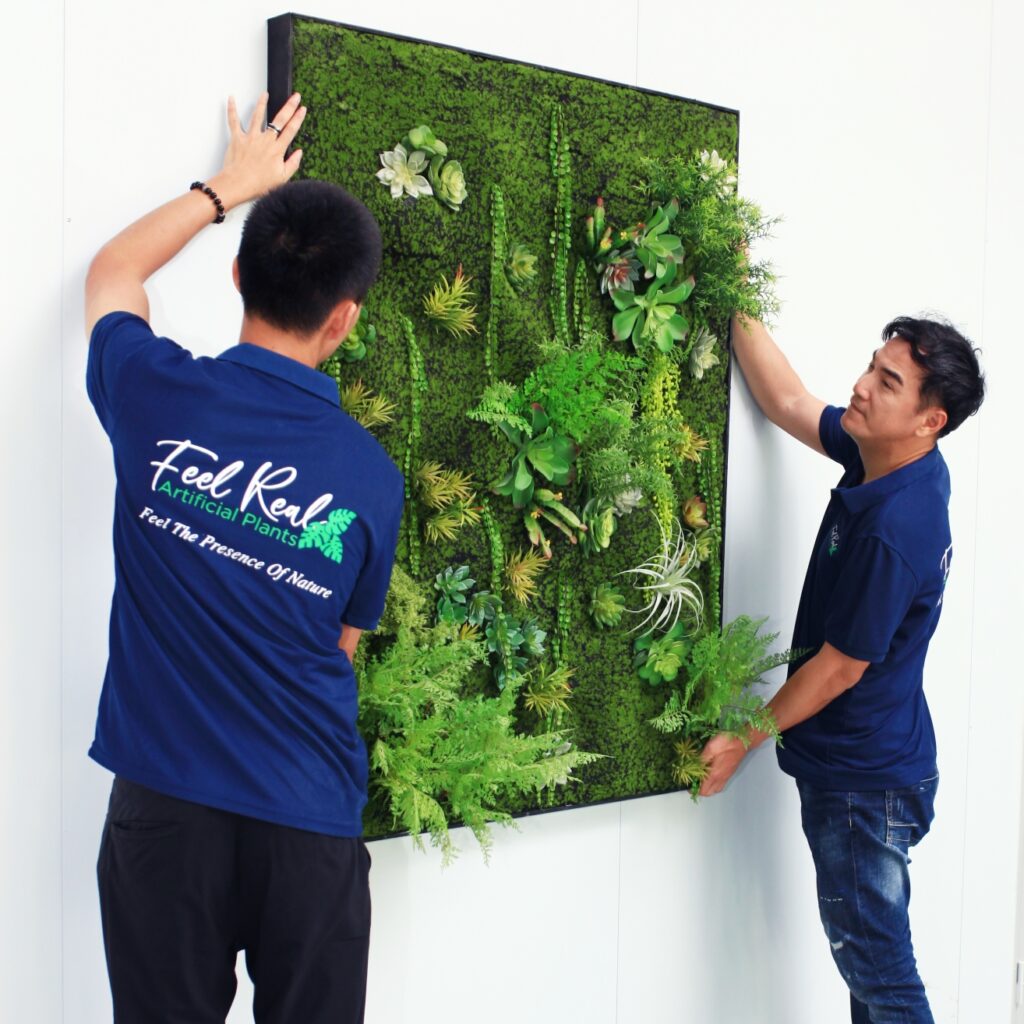
– Market Trends and Consumer Preferences
Keeping up with market trends and consumer preferences is vital for wholesalers in the artificial green wall industry. The market is dynamic, and tastes continually evolve, making it essential for wholesalers to stay informed and adapt their offerings accordingly.
One key trend is the growing preference for specific types of plants and wall designs. Consumers are increasingly drawn to certain styles, such as tropical foliage, minimalist greenery, or native plant designs. These preferences can vary widely depending on the region, current design trends, and individual client tastes. You should ensure the product range includes a variety of plant types and design styles to cater to these diverse preferences. Regular market research and client feedback can help wholesalers stay aware of these trends and adjust their inventory as needed.
Another significant trend is the movement towards eco-friendly and sustainable products. As environmental awareness grows, consumers are more inclined to choose products that are sustainable and have a lower environmental impact. Even though artificial green walls are inherently less eco-friendly than living plants, wholesalers can still address this trend by focusing on sustainability in other aspects. This can include using recycled or eco-friendly materials in the construction of the green walls, adopting sustainable practices in manufacturing and shipping, and promoting the longevity and energy efficiency of their products.
Offering a range that aligns with these trends is crucial for wholesalers. It positions you as forward-thinking and responsive to the needs of the market. By demonstrating a commitment to sustainability and staying attuned to evolving design preferences, you can appeal to a broader customer base and differentiate themselves in a competitive market.
For artificial plants wholesalers, the potential in green walls is immense. By focusing on quality, design versatility, and market needs, you can not only expand their business but also contribute to a more sustainable and aesthetically pleasing urban environment. The future looks bright, and green, for those ready to embrace this growing trend.
